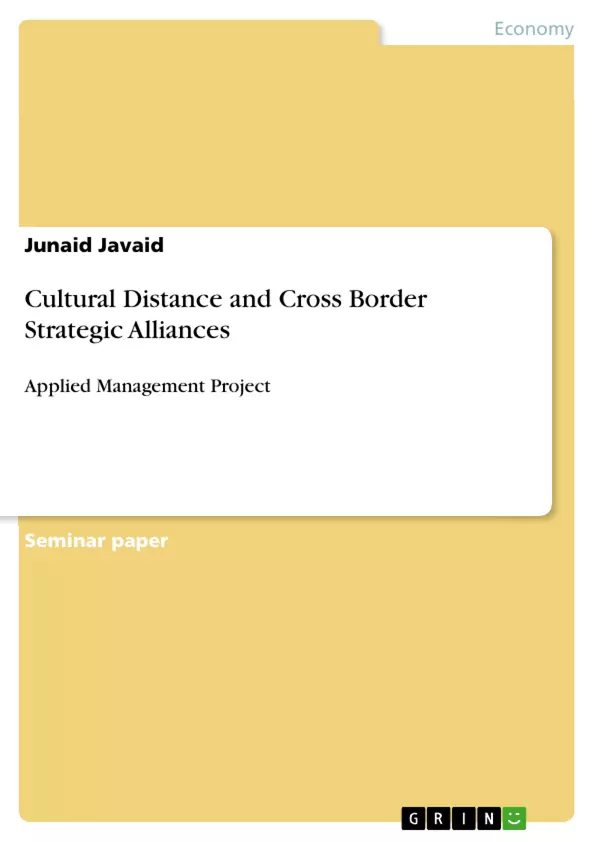In the environment of Global Markets, the concept of International Joint Ventures (IJV) is appearing as a common phenomenon and there is a huge number of corporations who are successful in experiencing considerable growth and expansion through this strategic form of alliances. This report is made in accordance with context of cultural differences in an approach to investigate the phenomenon that to measure the degree of influence of cultural differences on the performance of International Joint Venture (IJV) at both context (National Level Culture & Organisational Level Culture). Cuplan (2002) described International Joint Venture as a process which involves the inclusion of two or more companies from different countries who come together on the single platform with the intension of contributing each other resources and capabilities in creating a separate Business Unit. The process involved in this strategic alliance can be evaluated and analysed through various ways but the best approach is Culpan (2002) approach, this approach viewed each stage from the context of decision making involved in it. From the perspective of this appropriate approach the process of International Joint Venture (IJV) is made up of four different phases (Initial, Formation, Operation and Outcome). The Joint Venture named Alcatel-TCL was also made with the intension of becoming Global Leader in the mobile handset manufacturing. The focus was more on the two aspects (Design and Technology). Moreover, the secondary focus was on the integration of four components (Development Targets, Management System, and Operational Decisions & Staff Treatment). But, after 8 months (17-May-2005) the Joint Ventured was dissolved and both companies had decided to carry on their operations on the Individual basis. Generally it has been realised that the cultural distance existed at the organisational level was the prominent cause of given Joint Venture dissolution. And within the organisational context, the difference existed among both companies in term of open vs. Closed system orientation was the only factor which made difficult for the Alcatel-TCL to sustain for a long period of time.
Inhaltsverzeichnis (Table of Contents)
- Chapter 1- Aims & Objectives
- 1.1. Background Context
- 1.2. Research Question
- 1.3. Research Objective
- 1.4. Summary
- Chapter 2- Literature Review
- 2.1. The Concept of International Joint Ventures (IJV)
- 2.2. International Joint Ventures (IJV) Process
- 2.3. Cultural Aspect in International Joint Venture (IJV)
- 2.4. National Culture
- 2.4.1. Power Distance Index
- 2.4.2. Uncertainty Avoidance
- 2.4.3. Individualism vs. Collectivism
- 2.4.4. Masculinity vs. Femininity
- 2.4.5. Long-term vs. Short-term Orientation
- 2.5. Organisational Culture
- 2.5.1. Process vs. Result Orientation
- 2.5.2. Employee vs. Job Orientation
- 2.5.3. Parochial vs. Professional Orientation
- 2.5.4. Open vs. Closed System Orientation
- 2.5.5. Loose vs. Tight Control Orientation
- 2.5.6. Normative vs. Pragmatic Orientation
- 2.6. Summary
- Chapter 3- Case Study
- 3.1. Case-Study on Alcatel-TCL Joint Venture
- 3.1.1. International Joint Venture Process
- 3.1.2. Partners' Cultures
- 3.1.2.1. Alcatel (Partner:1) Culture
- 3.1.2.2. TCL (Partner:2) Culture
- 3.1.3. Findings
- 3.2. Summary
- Chapter 4- Discussion & Conclusion
- 4.1. Discussion
- 4.2. Conclusion
- 4.3. Recommendations
Zielsetzung und Themenschwerpunkte (Objectives and Key Themes)
This report explores the impact of cultural distance on the success of international joint ventures (IJVs). The study aims to examine how cultural differences at both the national and organizational levels can influence the performance of IJVs.- The importance of international joint ventures (IJVs) as a strategic alliance for global growth and expansion.
- The critical role of cultural differences in influencing the success of IJVs.
- The impact of national cultural dimensions, such as power distance, uncertainty avoidance, and individualism vs. collectivism, on IJV performance.
- The influence of organizational culture, including process vs. result orientation, employee vs. job orientation, and open vs. closed system orientation, on IJV success.
- A case study analysis of the Alcatel-TCL joint venture, focusing on the role of cultural distance in its dissolution.
Zusammenfassung der Kapitel (Chapter Summaries)
- Chapter 1: This chapter provides a background on international joint ventures (IJVs) and their significance in global markets. It outlines the research question and objectives of the study, focusing on the impact of cultural differences on IJV performance.
- Chapter 2: This chapter presents a literature review on the concept of IJVs, the IJV process, and the cultural aspects influencing their success. It discusses national cultural dimensions like power distance and individualism vs. collectivism, as well as organizational culture dimensions such as process vs. result orientation.
- Chapter 3: This chapter focuses on a case study analysis of the Alcatel-TCL joint venture. It examines the IJV process, the cultural characteristics of the partner companies, and the findings related to the joint venture's dissolution.
Schlüsselwörter (Keywords)
This report focuses on the significant role of cultural distance in influencing the success of international joint ventures. It delves into the importance of understanding national culture dimensions, such as power distance and uncertainty avoidance, and organizational culture dimensions, such as open vs. closed system orientation, to navigate the complexities of cross-cultural collaborations. Key concepts explored include international joint ventures (IJVs), cultural distance, national culture, organizational culture, and case study analysis.- Quote paper
- Junaid Javaid (Author), 2013, Cultural Distance and Cross Border Strategic Alliances, Munich, GRIN Verlag, https://www.grin.com/document/232220



